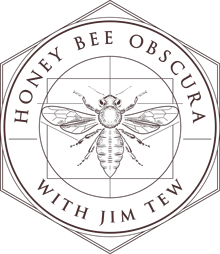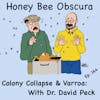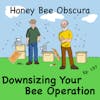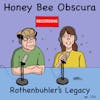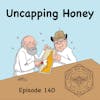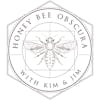Managing Nucs with Anne Frey (170)

In this episode of Honey Bee Obscura, we dive into the intricacies of nurturing nucleus colonies (nucs) with beekeeping expert Anne Frey from Better Bee. Jim and Anne discuss the benefits and methods of working with nucs, emphasizing their role in...

In this episode of Honey Bee Obscura, we dive into the intricacies of nurturing nucleus colonies (nucs) with beekeeping expert Anne Frey from Better Bee. Jim and Anne discuss the benefits and methods of working with nucs, emphasizing their role in sustainable beekeeping practices. Anne shares her extensive experience, focusing on the use of double nucs and their construction, management, and advantages for beekeepers, especially when it comes to overwintering.
This insightful discussion covers the strategic timing for creating nucs, the critical aspect of queen selection and management within these smaller colonies, and the overall impact on beekeeping success. The episode also touches on the challenges of maintaining the desired size of nucs throughout the beekeeping season and strategies for utilizing them as a resource within the apiary for colony health and expansion.
Listen today and gain a deeper understanding of nucs as a versatile tool in beekeeping, capable of enhancing their apiary's resilience and productivity.
______________________
Thanks to Betterbee for sponsoring today's episode. Betterbee’s mission is to support every beekeeper with excellent customer service, continued education and quality equipment. From their colorful and informative catalog to their support of beekeeper educational activities, including this podcast series, Betterbee truly is Beekeepers Serving Beekeepers. See for yourself at www.betterbee.com
______________________
Honey Bee Obscura is brought to you by Growing Planet Media, LLC, the home of Beekeeping Today Podcast.
Music: Heart & Soul by Gyom, All We Know by Midway Music; Christmas Avenue by Immersive Music; original guitar music by Jeffrey Ott
Cartoons by: John Martin (Beezwax Comics)
Copyright © 2024 by Growing Planet Media, LLC

Episode 170 – Managing Nucs with Anne Frey
[music]
Jim Tew: Hello listeners. Still wintertime here, but at least it's a nice day today and I feel better about the opportunity of spring being just a few weeks away, ideally. As usual, there's something that's on my mind and this time it's, should I be getting ready in the upcoming spring months to work with nucleus colonies. This time a year from now as others have done, I might be trying the winter nucs. There's all kind of reasons for that, keeping our bees smaller. I'm here with Anne Frey. Hi Anne.
Anne Frey: Hi Jim.
Jim: She's much more adept at this than I am and she's agreed to talk with us for a while. Stand by, let's talk about using nucs for whatever you want to use them for, but particularly trying to get them to survive the winter. I'm Jim Tew, I'm coming to you about once a week from Honey Bee Obscura where we talk about everything beekeeping and I'm with--
Anne: Anne Frey, from Better Bee, Jim.
Jim: We'll give this the best shot that we can. Please stand by.
[music]
Introduction: Welcome to Honey Bee Obscura, brought to you by Growing Planet Media, the producers of the Beekeeping Today podcast. Join Jim Tew, your guide through the complexities, the beauty, the fun, and the challenges of managing honeybees. Jim hosts fun and interesting guests who take a deep dive into the intricate world of honeybees. Whether you're a seasoned beekeeper or just getting started, get ready for some plain talk that'll delve into all things honeybees.
Jim: Anne, I've said too much already in previous segments. I've even got involved with this with Dr. Peck, who's there pretty much at your elbow. I've got a thing now late in my life for small hives. One of the things that I'll bring up while you and I chat is the convenience of a small hive. It's a little bit like playing with a kitten instead of trying to play with a cat. [chuckles] Tell me something about these nucs that you're working with. What size are they? How many frames, when do you make them up? Why do you do it and why should other people be doing it too?
Anne: Well, just that? Okay. [laughs] What we do mostly at Better Bee almost exclusively is we use double nucs and that means that for each unit there's two nucs in it and the unit looks like a double-deep 10-frame hive from the outside if you glance at it. It uses a normal telescoping outer cover and the height is the same as two deeps, but on the left there's one nuc with its entrance facing, say Northeast and on the right is another nuc with its entrance facing southwest. They run up four frames at the bottom and four frames at the top in each nucs or maybe three frames at the top plus a division board feeder. They are eight-frame nucs, eight-frame deeps.
Jim: When I was a younger man, we called those duplex hives.
Anne: Yes, that's a good name.
Jim: Is that name gone now? Because this was literally 35 years ago, but a duplex hive was exactly what you described.
Anne: Yes, that's a good name for it, but I've never heard that name. I know that a long time back, maybe like in 2000 I started to see this sort of thing and I heard a lot about Kirk Webster doing it and variations and I heard a lot about Mike Palmer in Vermont doing it and Kirk is in Vermont too. They're the gurus in this area of double nucs and I follow their techniques.
Jim: There was a time at Ohio State many years ago when the beekeeping program before my time, thought they could make a living selling queens. They had the students build 500 or 600 five-frame nucs boxes. The queen thing didn't work out, too much labor. There was not enough ability amongst students trying to keep that big of an operation going. When I took the job, I had 500 five-frame nucs boxes. I thought, well, as the time passed, I'll winter these over. I tried to winter those in Ohio winters and five-frame freestanding nucs.
That didn't work well. This went on for years. Now, I don't want to drag out our time bogged down with this. I tried to put 5 to 9, 10 of these side by side and then I covered them in styrofoam. I tried to make a community of these to see if they could share some communal heat.
Anne: Group them together.
Jim: I'll finish quickly on this. The thing that went wrong with that was that I attracted every mouse at about a two-mile radius it seems. When I would take that top off, there would be mice, that would scamper everywhere by the dozens.
Anne: They loved you.
Jim: They did love me.
Anne: Right up your leg.
Jim: Well, I wanted to go with that, I'm dragging this out. Did you see that the bees cluster to that central wall?
Anne: Oh, yes, they definitely do. In the bottom level, it's a three-quarter-inch thick wall between the left and right. That transmits enough heat for them to notice it and they cluster around it. It's not two clusters in the double nuc, it's one on the center wall. In the top layer, that wall is double thick because the top is actually two four-frame supers we call them, but they still cluster against the central divider. Yes, they'll share in warmth right through that whatever it is, one or two wood going up the center.
Your nucs might've just never been able to share enough heat. I'm thinking that maybe stacking them might have been another thing you could have done, but yes, heat is significant.
Jim: That was why I was trying to figure out some way to help them with community heat, I will call it. The reason I was doing it, I don't know why you're doing it there, it better be, but I was doing it because in the fall of the year, I had bees everywhere. This was so long ago that varroa was not yet an issue. We had really powerful colonies and we'd raised queens all season long. I had the bees and I had the queens, but I didn't have the season. It was ending time of the year. That was why I was trying to see if I could make splits in the fall and get them through the winter.
I even went as far as to use some of our bees we had in Florida at the time to make splits in Florida and then haul them up to Ohio. That's the job, that's the energy, that's the enthusiasm of a much younger man than I'm now.
Anne: Well, I've never done migratory beekeeping. I don't envy you there. Yes, wintering in a five-frame box, we also did that one winter in a small way just because we ran out of our double nuc equipment and we were still gung-ho to make nucs. The five framers did not come through the winter well. In New York state where we are, we're halfway up, the height of New York state near Saratoga Springs. Yes, same experience as you.
Jim: It's a good time to take a break because I'm about to change the subject. Let's come back from a break and I want to go right into indoor wintering of nucs.
Anne: All right, I'll try to be ready.
[music]
Betterbee: Are you an experienced beekeeper? Eager to try something new? Try making comb honey. Better Bee has you covered. Our range of ready-to-use systems, including hog half comb and Ross Rounds makes it a breeze to get started or craft your own cut comb right in your existing frames. With Better Bee's expert guidance, you'll soon be harvesting delicious comb honey. Explore the options @betterbee.com/combhoney.
Jim: I guess you could say, Anne, I must be a slow learner because I had something less than remarkable success wintering these nucs outside. I had the facility, I had the building, I tried to put about 125 to 150 nucs inside a building, insulated room. I was just trying to hold them at around 45 degrees. It's not like it was toasty warm in there and it didn't work any better for similar reasons. I couldn't keep the bees in the box. They wouldn't stay calm. If you had a really nice day and the temperature in that room got up to 50, 55, they became active.
They would come out and then you got bees at the windows and bees are out. It was just not a pretty picture. I know people winter nucs, but I think they must have better control over the temperature and the humidity than I did with my primitive situation.
Anne: Yes, it's quite a science. I've never done anything with that myself either but I know there's humidity control and I think no windows. I think it's constantly dark, so it's nothing to just jump into.
Jim: CO₂ is also an issue. They had to have some circulation system, so I was doomed to fail before I ever really got into this. I got to tell you, after though, I've just taken spanking after spanking with this wintering nucs thing. I just don't let it go because I've confessed even in this podcast that I'm talking in now, that I like those smaller hives. They're easier for me to work with at this stage in my life, they're more agreeable to my near neighbors, I don't have these big colonies, so I just can't let this concept go.
I'm glad that you're working with it. There's these insulated boxes too. There's these expanded polystyrene insulated boxes that, in theory, would have more insulatory qualities than wooden boxes. I don't know how to comment on that. I do know that sometimes those boxes hold water more. Do you have any experience with the insulated boxes?
Anne: Yes, I do. It does seem that there is a puddle at the bottom. I'm thinking that that is mainly the condensed breath of the bees that has run down the walls and gathered at the bottom overall of the days of winter. They usually have much more extensive ventilation than wooden boxes do. I should say that on every nuc and hive we have that has an insulated cover or a piece of insulation under the regular cover. Insulated hives, they are seven possibly. I would believe that's less than what bees get when they live inside of a tree. The thickness of a tree wall is pretty darn thick in the colonies, I've seen. The insulation above them in a tree is like the whole height of the tree. Everything we do is a little bit weird, but that's the way we do things. The idea of keeping them small though, that you keep referring to, and you said that about the kitten, I love that it's hard to keep these small, it's a constant struggle to keep a nuc a nuc. That's another issue besides overwintering is keeping them the size you want all through the summer and into early fall when they start to slow down.
Jim: You stepped on a nerve there because nucs beget nucs. That thing's going to outgrow that box-
Anne: Oh, yes.
Jim: -in a heartbeat.
Anne: We actually harvest frames from nucs to create other nucs and we use nucs to create drawn comb on foundation. You can't put bees in a nuc box and say, "Hey, I have a nuc," and think it's going to stay like that.
Jim: Kind of an odd question, but why don't you do this? Why does Better Bee, why does a beekeeper-- I know why I would do it, but why are you doing it and why do other beekeepers that you know of, why are they doing it?
Anne: There's a lot of reasons. The Better Bee reason is that we sell nucs. We have customers every spring who want to buy bees, and we provide overwintered nucs with queens that have been raised locally in the New York or Vermont, which is very close to us. Overwintered nucs have a certain cachet to them. Clearly, they've already made it through a winter, so they overwintered. The reason that other people might do it is that they want to have a backup on hand.
If their big hives died over the winter, say they had 10 big hives and two nucs and five of their big hives died, their honey production hives, their full-size double deeps, all they would have to do is not hold back those two nucs and just let them grow. They would have bounced right back to seven and they probably could split one of the remaining five hives and make more nucs, which would then by August be bounced back and they'd have 10 hives again.
Without bringing something that took all the equipment of a hive or all the bees or the population that needed an entire mite treatment or the amount of honey a hive needs all that through the winter, it's easier to take nucs through the winter and then let them go wild, which is what they want to do in the spring than to dedicate materials and bees to whole hives getting through the winter. Man, I'm rambling. Does that all seem clear to you, Jim?
Jim: [laughs] No, you're not rambling at all. There's a lot that can be done. Kim always called these nucs in the bee yard a toolbox. That was his wording. If you need something, you can go get it out of that nuc. If you need a frame or brood, if you need even a queen or if you've got too much brood. It was a toolbox to Kim. I've always said if you've got 10 colonies, probably one of them should be a four or five or six frame nuc just for recovery, for bandaids, whatever.
Anne: Yes. 10% to 20% of what you have, it would be great if it was nucs. A bandaid. I like the idea of having a queen too, because people usually think of if they want to have a few queens ready to go, they say, "How do I keep them? Do I bank them? Do I order them just in time when I'm going to need them?" Having them living along and laying eggs in a couple of nucs, two queens, two nucs, anytime you want to requeen two of your hives, all you need to do is kill the big hives queen and insert that entire nuc into a big wide gap that you've made in the-- I don't mean the entire nuc, but all the five frames from the nuc into a gap in the center of the frames in your hive.
It barely has a hiccup when you requeen by moving her with her bees and her brood combs straight into the hive. She's not in any kind of stress like she might be in a queen cage. She's pumping out the right pheromones as she's laying because laying queens have a different scent and tone to their lives than queens that have just been shipped in a cage. It's better for her and it's easier for the person to requeen with them.
Jim: I have an odd confession to make, is just-- I don't know if it's human nature or if it's my nature. Just to hypothetically say I've got a really nice five frame, new deep frames, great queen, good pattern, nicely imbalanced. It's just a nice little colony. One of my bigger colonies has a queen issue. I would just rather go have a medical procedure done than go take the queen out of that functional little nuc to give to the big colony that's not functional. I can't describe-- I promise you I would have the thought, can I just order a queen? Can I just go buy a queen?
The whole purpose of the nuc was to have the queen there at the ready and my thought is, "Oh, I don't want to tear that box apart. That's a nice little unit over there. It's in balance. It's good to go." I would go take the queen out and I would do it, but I would feel badly about it. I didn't know I would feel badly about it. I don't know how to describe it. I guess if it works, don't fix it kind of thing, and I'm tearing it apart.
Anne: On the other hand, that nuc is probably, if the queen is as wonderful as we feel she is, it's going to want to crowd herself up and get into a swarmy mood soon. Let's call it expanding that nuc instead of taking the queen out of it.
Jim: I know everything you're saying, I got you covered. I understand, except when it comes time to do it, I'll have this pang. I'll have a similar pang when I clean up winter kill. You just have these pangs every now and then, and I have a heart at that moment when it comes to intentionally damaging a functional tiny colony for the good of another.
Anne: Where is that Pang? Is it in your-
Jim: I don't know - conscience?
Anne: -in your brain, in your heart, in your back?
Jim: I don't know. I hadn't thought about that. I can have pangs in my back depending on what I'm doing wrong in the bee yard. I guess it's a conscience. I don't know what it is that I should have done something. I'll moue that. Before we go though, I did like to know this. You started those colonies, these nucs in the fall sometime when? August?
Anne: The nucs-
Jim: September?
Anne: -the double nucs that I'm referring to?
Jim: Right.
Anne: The double nucs, we make them in a rolling pattern of 50 a week, starting in mid-May. That goes on until about the end of July. We don't make any in August or September.
Jim: What I'm trying to ask is how old would you say the queen is when I get a nuc?
Anne: When you get one of our nucs, she might be as old as 10 months if she was one of the ones that started in May.
Jim: What I need to expect to requeen that nuc, if I'm going to get a year or so to it, the most out of a queen?
Anne: Oh, that depends on your feelings about requeening, but if it was that early, it starts out as a queen cell. She's probably only laying from June until November. She's been laying for five months. I would never say that a queen that's been laying for five months is too old to go on. No, they're really rare in the go when we sell them in the spring. No, but that's a valid concern, how old is the queen? They're more likely to want to swarm when they're older and less likely when they're very new. I wouldn't say these are as old as ones that havea feeling of swarminess.
Jim: They're not truly a tested queen, but in some ways, they're tested. You can look at the brood pattern.
Anne: Yes, it's a degree of scale. Oh, yes. The brood pattern has already been assessed and anyone that didn't look good has been weeded out. We've raised these queens and we raise the nucs, and we're so careful with every queen, but there's also a certain level of viciousness to it. We kill so many queen cells and queens as we call the ones that are not good enough and their pattern is not good enough. We're constantly watching out for that. It gives me a pang sometimes.
Jim: Well, we all have pang sounds like. [laughs] Listen, I like the idea of nucs. It's just me. I'm not trying to sell it to anyone else. They're just friendly little colonies that are easy to work, nice to photograph. They just don't make the big problems that the big colonies make, so I like them. I enjoyed talking to you about it. Thanks for the time you spent with us.
Anne: It was fun, Jim. All right, I'll see you next time.
Jim: I'll see you next time.
[00:20:37] [END OF AUDIO]
New to Honey Bee Obscura Podcast?
Here are some great episodes to start with. Or, check out episodes by topic.








